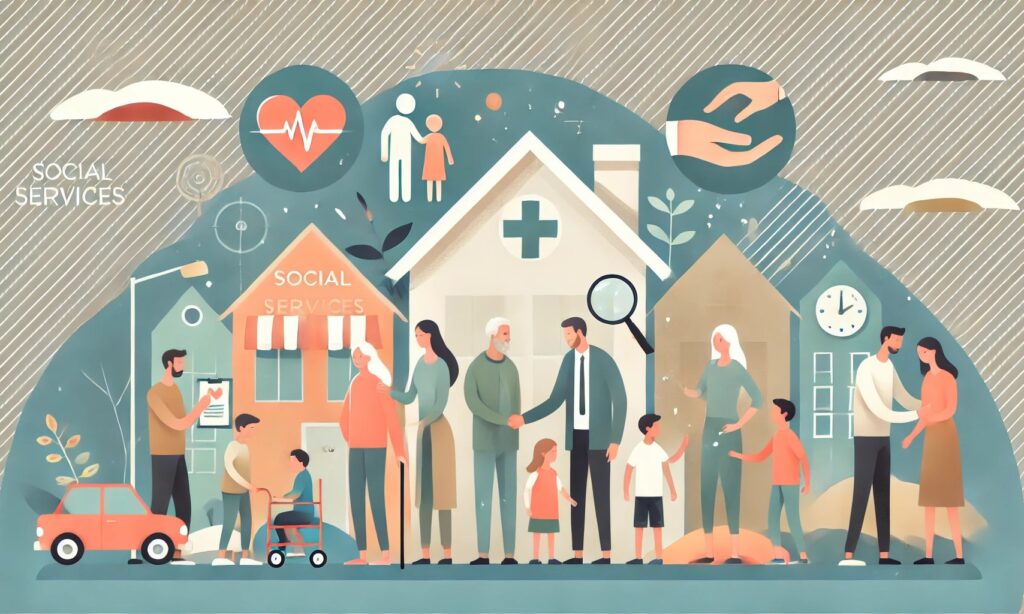Social Services can be defined as a number of services offered by the government or other authorities or by private institutions. These public services will focus on social development, community strengthening and promoting equity and opportunity.
Social Services
According to Harry. M Cassified “Social services are those organized activities that are primarily and directly concerned with the conversation, protection, and improvement of human resources. It includes social assistance, social insurance, child welfare, correctional services, mental hygiene, public health, education, recreation, labor protection, and housing”.
Social services are a branch of human services focused on improving individual and community well-being through support programs and interventions. Human services encompass a wide range of programs designed to enhance individuals’ overall well-being and meet basic human needs. Within this broad field, various professions work collaboratively to support people facing social, emotional, or economic challenges. Among these, social services play a crucial role by specifically addressing social problems, promoting welfare, and strengthening communities.
Human Services
The term Human Services may be described as those systems of services and allied occupations and professions that are predominantly aimed at enhancing or sustaining the physical and mental health, and overall welfare of individual, groups or communities in our society. Alfred Kahn has abstracted human services among the following four service categories:
Personal Services
Focus on helping individuals improve their emotional, social, and physical well-being through direct interaction and support (casework, counseling, recreation, rehabilitation, religion, therapy).
Protection Services
Aim to safeguard individuals and communities from harm, danger, or exploitation through enforcement and safety measures (consumer protection, corrections, courts, fire prevention/firefighting, housing code enforcement, law enforcement, public health services).
Information/Advisory Services
Provide guidance, knowledge, and resources to help individuals make informed decisions and solve personal or financial problems (consulting, consumer information, education, financial counseling, hotlines, library services).
Maintenance Services
Ensure individuals’ and families’ basic needs and financial security are met through ongoing support programs (child care, unemployment assistance, institutional services, public welfare programs, retirement plans, Social Security programs).
The delivery of support and aid occurs through social services. These services encompass the tasks performed by helping professionals to improve people’s health, enhance their quality of life, increase autonomy and independence, support families, and ultimately help individuals and larger systems improve their functioning within the social environment.
Social Agencies as Service Provider
Social services are generally provided through social agencies, sometimes referred to as “social welfare institutions”. These organizations are typically established by policies and laws to prevent, alleviate, or contribute to the solution of recognized social problems.
Social agencies are categorized based on their structure and funding source:
- Public Social Agencies are run by a designated unit of government and are usually regulated by laws that directly affect policy. An example is a county department of social services.
- Private Social Agencies are privately owned and operated by people not employed by the government. These services may resemble those provided by public agencies, such as counseling, family planning, or services for children and older adults.
- Nonprofit Social Agencies seek to accomplish a service provision goal rather than earning a profit for private owners. Funding often comes from taxes, private donations, grants, and service fees.
- Proprietary (For-Profit) Social Agencies are privately owned entities where a primary purpose is to earn a profit for the owners.
Types of Social Services

Social services cover a vast range of needs and problems addressed in specific areas (often called fields of practice):
Children and Families
These services encompass protective interventions and supportive programs designed to ensure child welfare and family stability, including foster care placement, adoption facilitation, child protection investigations, and family preservation services.
Health and Medical Services
This field provides essential healthcare delivery through institutional and clinical settings, offering diagnostic treatment, preventive care, patient advocacy, and care coordination services.
Mental Health and Behavioral Services
These services deliver comprehensive psychiatric and psychological interventions through outpatient, inpatient, and residential facilities to address mental illness, emotional disturbances, and behavioral disorders.
Aging and Gerontological Services
This specialty provides age-appropriate support systems designed to enhance quality of life and maintain independence for elderly populations through residential care, home-delivered meals, transportation assistance, and social engagement programs. Services address the unique physical, emotional, and social needs associated with aging while promoting dignity and autonomy.
Substance Use, Abuse, and Dependence
These programs offer evidence-based treatment modalities including detoxification, rehabilitation, counseling, and recovery support services for individuals struggling with alcohol and drug dependencies. Interventions employ comprehensive approaches combining medical treatment, behavioral therapy, and long-term relapse prevention strategies.
Poverty and Public Welfare (Financial Assistance)
This sector administers governmental and community-based programs that provide economic support, including cash assistance, food security programs, housing subsidies, and employment services to low-income individuals and families. Services aim to alleviate immediate financial hardship while promoting pathways toward economic self-sufficiency and social mobility.
Types of Financial Assistance Programs
Programs that provide income or financial benefits fall into two major policy categories:
- Social Insurance Programs (Based on Right): These programs are generally financed by taxes on employees, employers, or both. They are considered an individual’s right because they or their employers paid premiums. Examples include Old Age, Survivors, Disability, and Health Insurance (OASDHI), Unemployment Insurance, Workers’ Compensation, and Medicare.
- Public Assistance Programs (Based on Need): These programs provide financial benefits or in-kind benefits (services or goods rather than cash) to people who cannot support themselves. Eligibility is determined by a means test. Examples include Supplemental Security Income (SSI), Temporary Assistance to Needy Families (TANF) (which replaced AFDC), Medicaid, Food Stamps (SNAP), General Assistance, and Housing Assistance.
Core Functions of Social Services
We identify several critical functions that social services fulfill within modern communities.

Crisis Intervention
Provides immediate assistance for emergencies such as homelessness, domestic violence, food insecurity, and medical crises.
Long-Term Stability
Offers case management and connects clients with housing aid, employment training, childcare, and healthcare services.
Child Protective Services
Investigates abuse allegations, ensures child safety, and coordinates foster care placements.
Adult Protective Services
Protects elderly and disabled adults from neglect, exploitation, and abuse through monitoring and legal measures.
Preventive Programs
Develops educational initiatives on substance abuse, teen pregnancy, disease management, and financial literacy to promote self-sufficiency and reduce future crises.
The overall goal of social welfare is to enhance the social functioning of all age groups, both rich and poor, by fulfilling their social, financial, health, and recreational requirements. Social services are needed and demanded when other institutions (such as the market economy and the family) fail to meet the basic needs of individuals or groups.
Perspectives for Service Provision
The nature and scope of services provided are determined by underlying philosophical perspectives:
Residual View
This perspective views social services as temporary, focusing on problems and gaps. Services should be provided only when an individual’s needs are not met through other societal institutions (family and market economy). Aid is meant to be short-term, primarily for emergencies.
Institutional View
This contrasting view holds that people’s needs are a normal part of life, and society has an ongoing responsibility to support its members and provide needed benefits and services. Under this view, people have a right to receive services.
Skills Needed for Social Services
Effective delivery of social services requires practitioners to possess a wide range of knowledge and skills. Professionals providing social services (including social workers, urban planners, nurses, and attorneys) must be equipped to handle common social and personal difficulties. Essential skills guide practitioners through the planned change process (Engagement, Assessment, Intervention, Evaluation):
Counseling and Interviewing
The ability to counsel clients effectively is arguably the most fundamental and important skill. This involves developing a relationship, exploring problems, and examining alternative solutions.
Communication
Excellent oral and writing skills are vital for effective interaction with other professionals and groups. Workers must draft a wide variety of reports, such as grant proposals and court reports.
Research and Evaluation
Service providers need to critically analyze, monitor, and evaluate the effectiveness of interventions and programs. Accountability, or measuring the effectiveness of service programs, is increasingly required by funding sources.
Key Roles for Service Delivery
Service personnel often take on various professional roles to implement services and connect clients to programs:
- Broker: This role involves connecting individuals and groups who need help with appropriate community services.
- Case Manager/Coordinator: Professionals often coordinate services provided by multiple agencies to avoid duplication and ensure different services are working toward consistent objectives. This is particularly important for clients with multiple needs.
- Advocate: Serving to secure needed resources or promote fair and equitable treatment, especially when existing institutions are hostile or uninterested in providing necessary help.
- Educator: Providing clients with necessary information and teaching skills, such as job-hunting strategies or anger-control techniques.
- Facilitator: Guiding group activity, such as leading therapy, self-help, or educational groups.
The complexity of modern society necessitates this broad range of functions. The existence of numerous specialized social service agencies means that coordinating and ensuring client access to this vast network through roles like the broker and case manager becomes an essential component of service delivery.






